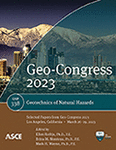A Simplified Model for Predicting Wind Erosion of Moistened Sands
Publication: Geo-Congress 2023
ABSTRACT
Wind erosion is responsible for the formation of various landforms and poses a significant risk to health, food security, and infrastructure. On Earth, the initiation of wind erosion is affected by the water content of the sediments, which can significantly increase the friction threshold velocity (FTV), which is the minimum wind velocity at the bed surface needed to initiate particle mobilization. Incorporating the effect of water on FTV is essential to assess problems such as sandstorm formation, topsoil removal in crops, or sand dune migration. In this study, a theoretical model is proposed to calculate the FTV in sands and horizontal surfaces using the principles of unsaturated soil mechanics. The sand matric suction is incorporated using soil water retention curves (SWRC). Two SWRCs are used resulting in simple functional forms that are easy to use. Data from the literature and new wind tunnel experiments are used to calibrate and validate the suggested FTV model. The results support the use of the proposed simplified equation as providing an adequate prediction of the FTVs of moistened sands.
Get full access to this article
View all available purchase options and get full access to this chapter.
REFERENCES
ASTM. ASTM D4253. (2016). Test Methods for Maximum Index Density and Unit Weight of Soils Using a Vibratory Table. ASTM International, West Conshohocken, PA.
ASTM. ASTM D4254. (2016). Test Methods for Minimum Index Density and Unit Weight of Soils and Calculation of Relative Density. ASTM International, West Conshohocken, PA.
Bagnold, R. A. (1941). The Physics of Blown Sand and Desert Dunes.
Benson, C. H., Chiang, I., Chalermyanont, T., and Sawangsuriya, A. (2014). “Estimating van Genuchten Parameters and n for Clean Sands from Particle Size Distribution Data.” From Soil Behavior Fundamentals to Innovations in Geotechnical Engineering, Atlanta, Georgia, American Society of Civil Engineers, 410–427.
Brooks, R. H., and Corey, A. T. (1966). “Properties of porous media affecting fluid flow.” Journal of the Irrigation and Drainage Division, 92(2), 61–90 Number: 2 Publisher: American Society of Civil Engineers.
Cavalcante, A. L. B., and Zornberg, J. G. (2017). “Efficient Approach to Solving Transient Unsaturated Flow Problems. I: Analytical Solutions.” International Journal of Geomechanics, 17(7), 04017013 Publisher: American Society of Civil Engineers.
Charbonneau, B. R. (2019). From The Sand They Rise: Post-Storm Foredune Plant Recolonization And Its Biogeomorphic Implications. Ph.D. thesis, University of Pennsylvania, University of Pennsylvania. ISBN: 1392685672.
Dong, Z. (2002). “Wind initiation thresholds of the moistened sands.” Geophysical Research Letters, 29(12), 1585.
Ferreira, M. C. S., Furieri, B., de Morais, C. L., Stocco, J. F., Reis, N. C., Harion, J.-L., and Santos, J. M. (2020). “Experimental and numerical investigation of building effects on wind erosion of a granular material stockpile.” Environmental Science and Pollution Research, 27(29), 36013–36026.
Fécan, F., Marticorena, B., and Bergametti, G. (1999). “Parametrization of the increase of the aeolian erosion threshold wind friction velocity due to soil moisture for arid and semi-arid areas.” Annals of Geophysics, 17, 149–157.
Greeley, R., and Iversen, J. D. (1987). Wind as a geological process: on Earth, Mars, Venus and Titan. CUP Archive Issue: 4.
Han, Q., Qu, J., Zhang, K., Zu, R., Niu, Q., and Liao, K. (2009). “Wind tunnel investigation of the influence of surface moisture content on the entrainment and erosion of beach sand by wind using sands from tropical humid coastal southern China.” Geomorphology, 104(3-4), 230–237.
Ishihara, T., and Iwagaki, Y. (1952). “On the Effect of Sand Storm in Controlling the Mouth of the Kiku River.” Disaster Prevention Research Institute, Kyoto University, 2, 1–32.
McKenna-Neuman, C., and Nickling, W. G. (1989). “A theoretical and wind tunnel investigation of the effect of capillary water on the entrainment of sediment by wind.” Canadian Journal of Soil Science, 69(1), 79–96.
Ravi, S., Zobeck, T. M., Over, T. M., Okin, G. S., and D’Odorico, P. (2006). “On the effect of moisture bonding forces in air-dry soils on threshold friction velocity of wind erosion: Wet bonding forces and wind erosion.” Sedimentology, 53(3), 597–609.
Shao, Y. (2008). Physics and modelling of wind erosion. Number 37 in Atmospheric and oceanographic sciences library. Springer, S.l., 2. rev. & exp. ed edition OCLC: 837050860.
Zambrano-Cruzatty, L., Stark, N., and Yerro, A. (2018). “The effect of shear strength and moisture content on the fluid velocity threshold of wind erosion.” Coastal Engineering Proceedings, (36), 86.
Zambrano-Cruzatty, L., Yerro, A., and Stark, N. (2019). “Influence of Shear Strength and Moisture Content on Aeolian Sand Erosion.” Geo-Congress 2019, Philadelphia, Pennsylvania, American Society of Civil Engineers, 1–10.
Zambrano-Cruzatty, L. E. (2021). Advancements for the Numerical Simulation of Free Fall Penetrometers and the Analysis of Wind Erosion of Sands. Ph.D. thesis, Virginia Polytechnic Institute and State University, Blacksburg, Virginia.
Information & Authors
Information
Published In
History
Published online: Mar 23, 2023
ASCE Technical Topics:
- Aerodynamics
- Business management
- Continuum mechanics
- Dynamics (solid mechanics)
- Engineering mechanics
- Erosion
- Geology
- Geomechanics
- Geotechnical engineering
- Health hazards
- Hydrologic engineering
- Hydrology
- Moisture
- Particle velocity
- Practice and Profession
- Public administration
- Public health and safety
- Sandy soils
- Soil dynamics
- Soil mechanics
- Soil properties
- Soil suction
- Soil water
- Soils (by type)
- Solid mechanics
- Structural engineering
- Water and water resources
- Wind engineering
Authors
Metrics & Citations
Metrics
Citations
Download citation
If you have the appropriate software installed, you can download article citation data to the citation manager of your choice. Simply select your manager software from the list below and click Download.
